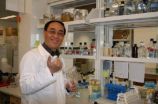(Press-News.org) AUGUSTA, Ga. – Saving a soldier's life takes precedence over treating traumatic urologic injuries on the battlefield, a Medical College of Georgia researcher says.
Injuries to the bladder, ureters, kidneys and external genitalia often require complex surgical treatment, said Dr. Arthur Smith, an MCG urologist. But during wartime, when those wounds are often combined with other life-threatening injuries, their treatment becomes secondary to lifesaving tactics.
Smith made his comments at a lecture, Revised Management Strategies for Urologic Injuries During Wartime, at the Warrior Health Symposium in Canberra, Australia Oct. 30. The symposium is co-sponsored by the Australian Military Medical Association and the Australian Defense Force Joint Health Command.
"Most urological injuries occurring in the civilian setting result from blunt trauma, but they are far fewer in occurrence and their treatment is generally implemented in a straightforward way with an organized and well-supported health care system," he said. "During wartime, though, penetrating injuries are more common and rarely occur in isolation, because victims often receive multiple injuries concurrently. Treatment options must change and be prioritized."
Treating multiple injuries is only part of the problem.
"Other variables," Smith said, "commonly affect surgical intervention: the status of resources, the number of other casualties and, of course, the overall tactical situation."
Advanced weapons such as improvised explosive devices and multiple fragmentation munitions that cause a wide spectrum of injuries also complicate matters, he added. Because treating urologic injuries is a lower priority, complications often arise. In some cases, injuries are discovered later or missed altogether.
"During wartime, casualties are all managed through echelons of care," Smith said. "When someone is injured, he may be treated on the battlefield, at a field hospital, at an evacuation hospital and then transferred to a more permanent location."
All of those echelons require different treatment strategies, he explained. On the battlefield, treatment is most likely focused on stopping the bleeding; field hospital treatment may include early life-saving amputations; at an evacuation hospital, there may be surgery to repair wounds – and urologic injuries, especially those to the kidneys and internal organs – may not be discovered until then.
"What we have to realize is that it's a very fluid situation often comprised of variable facilities, austere conditions and limited logistics support and evacuation staff. We often have to treat with a damage-control mentality."
INFORMATION:
Wartime urologic injuries require different mindset
2010-10-30
ELSE PRESS RELEASES FROM THIS DATE:
Women with anorexia nervosa more likely to have unplanned pregnancies
2010-10-30
CHAPEL HILL, N.C. – A new study by University of North Carolina at Chapel Hill and Norwegian researchers has found that women with anorexia nervosa are much more likely to have both unplanned pregnancies and induced abortions than women who don't have the serious eating disorder.
These results may be driven by a mistaken belief among women with anorexia that they can't get pregnant because they are either not having menstrual periods at all or are having irregular periods, said Cynthia M. Bulik, PhD, the study's lead author and director of the UNC Eating Disorders Program.
"Anorexia ...
Is the shape of a genome as important as its content?
2010-10-30
If there is one thing that recent advances in genomics have revealed, it is that our genes are interrelated, "chattering" to each other across separate chromosomes and vast stretches of DNA. According to researchers at The Wistar Institute, many of these complex associations may be explained in part by the three-dimensional structure of the entire genome. A given cell's DNA spends most of its active lifetime in a tangled clump of chromosomes, which positions groups of related genes near to each other and exposes them to the cell's gene-controlling machinery. This structure, ...
Scientists seek urgent treatment for fatal sleeping sickness
2010-10-30
Urgently-needed new treatment for a parasitic disease is being investigated in research led at the University of Strathclyde in Glasgow, Scotland.
Human African Trypanosomiasis, also known as sleeping sickness, affects between 50,000 and 70,000 people in Africa and South America. It is transmitted through the bite of the tsetse fly and attacks the nervous system and brain, leading to fever, headaches and disturbed sleep patterns.
Without treatment, the disease is fatal but a new drug to tackle it is being developed in a project led at Strathclyde, with partners from ...
Raising giant insects to unravel ancient oxygen
2010-10-30
Boulder, CO, USA - The giant dragonflies of ancient Earth with wingspans of up to 70 centimeters (28 inches) are generally attributed to higher oxygen atmospheric levels in the atmosphere in the past. New experiments in raising modern insects in various oxygen-enriched atmospheres have confirmed that dragonflies grow bigger with more oxygen, or hyperoxia.
However, not all insects were larger when oxygen was higher in the past. For instance, the largest cockroaches ever are skittering around today. The question becomes how and why do different groups respond to changes ...
Troubled islands: Hurricanes, oil spill and sea level rise
2010-10-30
Boulder, CO, USA - The islands flanking the outlet of the Mississippi River are not only facing losses due to sea level rise and local subsidence, according to one study, but new unknown impacts from oil recovery operations, say researchers working on another project. Both will be presenting their work on Nov. 1 and 2 at the meeting of the Geological Society of American in Denver. Some islands could disappear entirely in coming decades, exposing huge swaths of marshland to the waves of the open sea.
On one side of the Mississippi River outlet, to the east of the river ...
Newly discovered gene enables fish to 'disappear'
2010-10-30
Researchers led by Vanderbilt's Roger Cone, Ph.D., have discovered a new member of a gene family that has powerful influences on pigmentation and the regulation of body weight.
The gene is the third member of the agouti family. Two agouti genes have been identified previously in humans. One helps determine skin and hair color, and the other may play an important role in obesity and diabetes.
The new gene, called agrp2, has been found exclusively in bony fish, including zebrafish, trout and salmon. The protein it encodes enables fish to change color dramatically to match ...
Animal evolution springs from 'Snowball Earth'
2010-10-30
Biogeochemists have found new evidence linking "Snowball Earth" glacial events to the rise of early animals. The research was funded by the National Science Foundation (NSF).
Study results appear in this week's issue of the journal Nature.
The controversial Snowball Earth hypothesis posits that, on several occasions, the Earth was covered from pole to pole by a thick sheet of ice lasting for millions of years.
These glaciations, the most severe in Earth history, occurred from 750 to 580 million years ago.
In the aftermath, the researchers discovered, the oceans ...
Advance could change modern electronics
2010-10-30
CORVALLIS, Ore. – Researchers at Oregon State University have solved a quest in fundamental material science that has eluded scientists since the 1960s, and could form the basis of a new approach to electronics.
The discovery, just reported online in the professional journal Advanced Materials, outlines the creation for the first time of a high-performance "metal-insulator-metal" diode.
"Researchers have been trying to do this for decades, until now without success," said Douglas Keszler, a distinguished professor of chemistry at OSU and one of the nation's leading ...
Dracula orchids and goblin spiders
2010-10-30
Dracula orchids tempt flies by masquerading as mushrooms. Goblin spiders lurk unseen in the world's leaf litter. The natural world is often just as haunting as the macabre costumes worn on city streets, as highlighted by two studies published this year by curators in the Division of Invertebrate Zoology at the American Museum of Natural History, David Grimaldi and Norman Platnick.
DRACULA ORCHIDS
According to Grimaldi and colleagues, fruit flies (Drosophilidae) of the genus Zygothrica typically swarm on mushrooms and other rain forest fungi. But one group of orchids ...
Spice in curry could prevent liver damage
2010-10-30
ST. LOUIS -- Curcumin, a chemical that gives curry its zing, holds promise in preventing or treating liver damage from an advanced form of a condition known as fatty liver disease, new Saint Louis University research suggests.
Curcurmin is contained in turmeric, a plant used by the Chinese to make traditional medicines for thousands of years. SLU's recent study highlights its potential in countering an increasingly common kind of fatty liver disease called non-alcoholic steatohepatitis (NASH). Linked to obesity and weight gain, NASH affects 3 to 4 percent of U.S. adults ...






